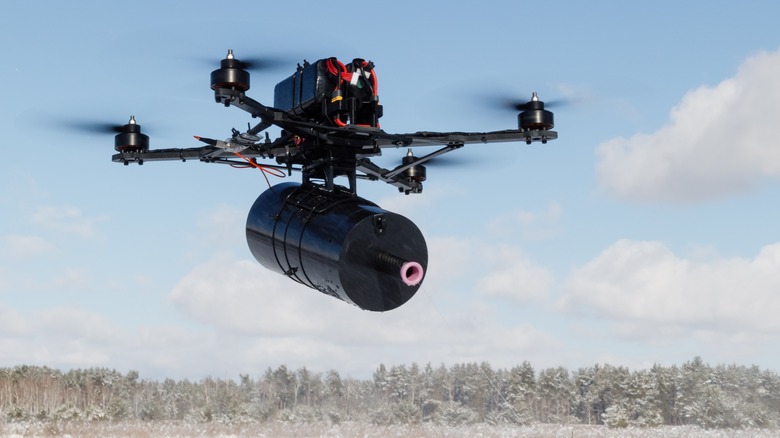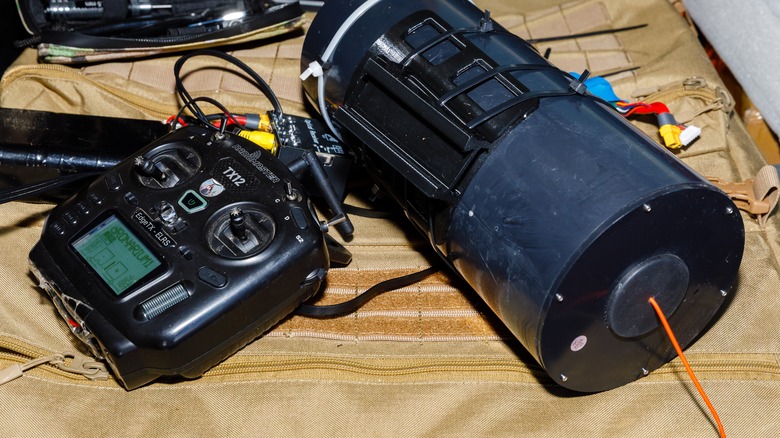Why Ukraine's Drones Have Fiber Optic Cables Attached, Explained
You may have seen some striking images coming out of Ukraine on social media where entire fields and city streets are covered in a dense tangle of glistening thread. This is the byproduct of a transformative (and terrifying) new weapon called the fiber-optic-guided first-person view (FPV) drone. The whole point is to bypass radio jammers by creating a direct, physical link between the drone and its pilot. One of the ways this can be achieved is by attaching a lightweight spool of optical fiber to the drone.
This unspools as the drone flies and can sometimes stretch tens of kilometers long. Passing through all that wire are video and control signals, effectively killing the need for radio signals — while also making the drone almost completely immune to the radio jamming and other electronic warfare (EW) tactics that have become rampant on the battlefield. It's all a part of a broader evolution in unmanned warfare, where FPV loitering munitions are changing the battlefield. The high-bandwidth physical line also provides a much clearer connection with virtually zero latency.
Fiber optics typically offer very low latency (well under 20 ms), while wireless radio connections in drones can sometimes go over 100 ms. This is a significant improvement over the often-messy, delayed video feeds of radio-controlled drones and allows pilots to fly into buildings or other types of cover while maintaining a perfect video feed right up to the target.
A race to catch up to a Russian innovation
Ukraine has been leveraging a range of high-tech tools in the war. This includes everything from Starlink-enabled recon drones to remote-controlled vehicles to counterbalance Russia's technological edge. But the introduction of the fiber optic drone in the spring of 2024 by Russia flipped the script, defying the stereotype of its military as a slow and cumbersome force. Russian military bloggers and commentators had been calling for a breakthrough to counter Ukraine's drone capabilities, and their engineers delivered.
The first model deployed at scale was the Knyaz Vandal Novgorodsky, which proved devastatingly effective targeting Ukrainian logistics routes in Kursk Oblast starting in August 2024. The impact was immediate. A Ukrainian medic named Dmytro told The Kyiv Independent, "Our logistics just collapsed; fiber optic drones were monitoring all routes."
Ukraine is now racing to close the gap. In February 2025, Ukraine's Unmanned Systems Forces unveiled the "Silkworm," a domestically-made modular fiber optic spool. It signals a serious push to ramp up domestic production and deployment.
With new technology comes new challenges on the battlefield
This new technology is not without significant drawbacks. The weight and bulk of the fiber optic spool mean the drone needs a larger frame, more powerful motors, and a bigger battery. This results in a slower, less maneuverable aircraft that is easier for troops to shoot down. This high-stakes operation is a world apart from the usual rules for avoiding trouble with a recreational drone. At the same time, the physical fiber itself creates a visible trail that can be highly reflective in the sun and potentially reveal the pilot's launch position. The technology is also described as "quite fragile."
A Ukrainian commander told TWZ in an interview that any mishandling can lead to an unintended explosion or a loss of control, and the thin cable can tear or get entangled in obstacles like trees. Furthermore, the immense popularity has created a supply chain crisis. Good manufacturers have long waiting lists, while many early systems were simply Chinese components resold by firms that didn't understand the military's specific needs.
As for countermeasures against these drones, they are limited to direct physical attempts, such as shooting the drones down or trying to catch them in large nets. The tactic has proven unreliable, though, as drones have been spotted flying right under them.


